Radiological Features of Male Breast Neoplasms: How to Improve the Management of a Rare Disease
- PMID: 38201413
- PMCID: PMC10795707
- DOI: 10.3390/diagnostics14010104
Radiological Features of Male Breast Neoplasms: How to Improve the Management of a Rare Disease
Abstract
The primary aim of our study was to assess the main mammographic and ultrasonographic features of invasive male breast malignancies. The secondary aim was to evaluate whether a specific radiological presentation would be associated with a worse receptor profile. Radiological images (mammography and/or ultrasound) of all patients who underwent surgery for male invasive breast cancer in our institution between 2008 and 2023 were retrospectively analyzed by two breast radiologists in consensus. All significant features of radiological presentation known in the literature were re-evaluated. Fifty-six patients were selected. The mean age at surgery of patients was 69 years (range: 35-81); in 82% of cases (46 patients), the histologic outcome was invasive ductal carcinoma. A total of 28 out of 56 (50%) patients had preoperative mammography; in 9/28 cases (32%), we found a mass with microcalcifications on mammography. The mass presented high density in 25 out of 28 patients (89%); the mass showed irregular margins in 15/28 (54%) cases. A total of 46 out of 56 patients had preoperative ultrasounds. The lesion showed a solid mass in 41/46 (89%) cases. In 5/46 patients (11%), the lesion was a mass with a mixed (partly liquid-partly solid) structure. We did not find any statistically significant correlation between major types of radiological presentation and tumor receptor arrangement. Knowledge of the main radiologic presentation patterns of malignant male breast neoplasm can help better manage this type of disease, which is rare but whose incidence is increasing.
Keywords: breast ultrasound; male breast cancer; mammography.
Conflict of interest statement
The authors declare no conflicts of interest.
Figures

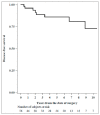
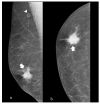
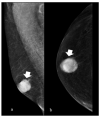
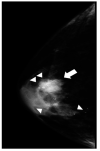
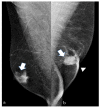


Similar articles
-
Responding to the challenges of breast cancer in egypt and other arab countries.J Egypt Natl Canc Inst. 2008 Dec;20(4):309-12. J Egypt Natl Canc Inst. 2008. PMID: 20571588
-
Our Radiological Experience on B3 Lesions: Correlation Between Mammographic and MRI Findings With Histologic Definitive Result.Clin Breast Cancer. 2019 Oct;19(5):e643-e653. doi: 10.1016/j.clbc.2019.06.004. Epub 2019 Jun 26. Clin Breast Cancer. 2019. PMID: 31377083
-
Male Breast Cancer with Radiological and Histopathological Findings.Sisli Etfal Hastan Tip Bul. 2020 Aug 22;54(3):375-379. doi: 10.14744/SEMB.2020.01643. eCollection 2020. Sisli Etfal Hastan Tip Bul. 2020. PMID: 33312039 Free PMC article.
-
[The HRT follow-up consultation. What to do in case of breast tumour (clinical or radiological) and microcalcifications. Postmenopausal women management: CNGOF and GEMVi clinical practice guidelines].Gynecol Obstet Fertil Senol. 2021 May;49(5):485-492. doi: 10.1016/j.gofs.2021.03.026. Epub 2021 Mar 20. Gynecol Obstet Fertil Senol. 2021. PMID: 33757919 French.
-
Adenoid Cystic Carcinoma of the Breast: Multimodality Imaging Findings and Review of the Literature.Acad Radiol. 2023 Jun;30(6):1107-1117. doi: 10.1016/j.acra.2022.10.003. Epub 2022 Nov 7. Acad Radiol. 2023. PMID: 36357304 Review.
Cited by
-
Male breast cancer: a multicenter study to provide a guide for proper management.Breast Cancer Res Treat. 2024 Nov;208(1):29-40. doi: 10.1007/s10549-024-07380-0. Epub 2024 Jun 19. Breast Cancer Res Treat. 2024. PMID: 38896332
References
-
- Steinitz R., Katz L., Ben-Hur M. Male breast cancer in Israel: Selected epidemiological aspects. Isr. Med. Assoc. J. 1981;17:816–821. - PubMed
-
- Waterhouse J., Muir C., Correa P., Powell J.R., editors. Cancer Incidence in Five Continents. Volume 3. IARC Scientific Publications; Lyon, France: 1976. p. 15.
-
- SEER*Explorer: An Interactive Website for SEER Cancer Statistics [Internet]. Surveillance Research Program, National Cancer Institute. [(accessed on 15 April 2021)]; Available online: https://seer.cancer.gov/explorer.
LinkOut - more resources
Full Text Sources

